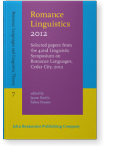On the structure of bare nominals in Brazilian Portuguese
Brazilian Portuguese (BrP) is different from other Romance languages in allowing bare nominals in argument position. In this paper we focus on the apparent differences between this language and other Romance languages, and on the structure that bare nominals have in this language. We argue basically for a Determiner Phrase (DP) analysis in which Number features are morphosyntactically specified on Determiners (as in French), i.e. on D, even if D is null. We show that BNs in this language may correspond to NPs and to DPs. As NPs, they are not specified for number and definiteness, can only occur as objects of a restricted class of predicates, and are interpreted as property-type expressions. As DPs, they have a null D that carries Number specification, introduce a discourse referent and are interpreted as entity-type expressions. We aim to show that BrP is neither a counterexample to the Universal DP Hypothesis nor to the Nominal Mapping Parameter.
References (38)
Borer, Hagit. 2005. In Name Only: Structuring Sense. Vol. 1. Oxford: Oxford University Press. 

Bošković, Željko. 2005. “On the locality of left branch extraction and the structure of NP”. Studia Linguistica 59.1–45. 

Bošković, Željko & Jon Gajewski. 2008. “Semantic correlates of the NP/DP Parameter”. Paper presented at NELS 39, Cornell University.
Bouchard, Denis. 2002. Adjectives, Number and Interfaces – Why Languages Vary. Amsterdam: Elsevier.
Carlson, Greg. 1980. References to Kinds in English. New York: Garland.
Chierchia, Gennaro. 1998. “Reference to kinds across languages”. Natural Language Semantics 6.339–405. 

Cinque, Guglielmo. 2005. “Deriving Greenberg’s Universal 20 and its Exceptions”. Linguistic Inquiry 36.315–332. 

Contreras, Heles. 1986. “Spanish bare NPs and the ECP”. Generative Studies in Spanish Syntax ed. by Ivonne Bordelois, Heles Contreras & Karen Zagona, 25–49. Dordrecht: Foris.
Cyrino, Sonia Maria Lazzarini. 1997. O Objeto Nulo no Português Brasileiro. Londrina: Editora da UEL.
Cyrino, Sonia Maria Lazzarini & Maria Teresa Espinal. 2015. “Bare Nominals in Brazilian Portuguese: more on the DP/NP analysis”. Natural Language and Linguistic Theory 33:471–521. DOI: 10.1007/s11049-014-9264-6.
Dobrovie-Sorin, Carmen & Brenda Laca. 1996. “Generic BNPs”. Ms., Paris VII/University of Strasbourg.
Dobrovie-Sorin, Carmen & Brenda Laca. 2003. “Les noms sans déterminant dans les langues romanes”. Les Langues Romanes – Problèmes de la Phrase Simple ed. by Danièle Godard, 235–281. Editions du CNRS.
Dobrovie-Sorin, Carmen, Tonia Bleam & Maria Teresa Espinal. 2006. “Bare nouns, number and types of incorporation”. Non-definiteness and Plurality ed. by Svetlana Vogeleer & Liliane Tasmowski, 51–79. Amsterdam & Philadelphia: John Benjamins. 

Espinal, Maria Teresa & Jaume Mateu. 2011. “Bare nominals and argument structure in Catalan and Spanish”. The Linguistic Review 28.1–39. 

Espinal, Maria Teresa & Louise McNally. 2007. “Bare singular nominal and incorporationg verbs”.
Proceedings of the 3
rd Nereus Workshop. Universität Konstanz Arbeitspapier 122, 45–62.
Espinal, Maria Teresa & Louise McNally. 2011. “Bare nominals and incorporating verbs in Catalan and Spanish”. Journal of Linguistics 47.87–128. 

Ferreira, Marcelo. 2005. “Bare habituals and plural definite descriptions”. Proceedings of Sinn und Bedeutung 9 ed. by Emar Maier, Corien Bary & Janneke Huitink, 102–115. Nijmegen: Radboud University.
Ferreira, Marcelo. 2010. “The morpho-semantics of number in Brazilian Portuguese bare singulars”. Journal of Portuguese Linguistics 91.95–116.
Galves, Charlotte. 2001. Ensaios sobre as Gramáticas do Português. Campinas: Editora da Unicamp.
Heycock, Caroline & Roberto Zamparelli. 2003. “Coordinated bare definites”. Linguistic Inquiry 34.443–469. 

Heycock, Caroline & Roberto Zamparelli. 2005. “Friends and colleagues. Plurality, coordination and the structure of DP”. Natural Language Semantics 13.201–270. 

Kallulli, Dalina. 1999. The comparative syntax of Albanian. On the contribution of syntactic types to propositional interpretation. Ph.D. dissertation, University of Durham.
Lasnik, Howard. 1981. “Restricting the theory of transformations: A case study”. Explanation in Linguistics ed. by Norbert Hornstein & David Lightfoot, 152–173. London: Longman.
Longobardi, Giuseppe. 1994. “Reference and proper names”. Linguistic Inquiry 25.609–665.
Longobardi, Giuseppe. 2001. “The structure of DPs: Some principles, parameters and problems”. The handbook of syntactic theory ed. by Mark Baltin & Chris Collins, 562–603. London: Blackwell. 

Lopes, Ruth. 2006. “Bare Nouns and DP number agreement in the acquisition of Brazilian Portuguese”. Selected Proceedings of the 9th Hispanic Linguistics Symposium ed. Nuria Sagarra & Almeida Jaqueline Toribio, 252–262. Somerville, Mass.: Cascadilla Proceedings Project.
Munn, Alan & Cristina Schmitt. 2005. “Number and indefinites”. Lingua 115.821–855. 

Pereltsvaig, Asya. 2006. “Small nominals”. Natural Language and Linguistic Theory 24.433–500. 

Pereltsvaig, Asya. 2007. “The universality of DP: A view from Russian”. Studia Linguistica 61.59–94. 

Pereltsvaig, Asya. 2011. “On number and number-neutrality in languages with and without articles”. Paper presented at the Workshop on Languages With and Without Articles, Paris. March 2011.
Roodenburg, Jasper. 2004. “French bare arguments are not extinct: the case of coordinated bare nouns”. Linguistic Inquiry 35.301–313. 

Schmitt, Cristina & Alan Munn. 1999. “Against the Nominal Mapping Parameter: Bare Nouns in Brazilian Portuguese”. Proceedings of NELS 29 ed. by Pius Tamanji, Mako Hirotani & Nancy Hall, 339–353. University of Delaware.
Simioni, Leonor. 2007. “A concordância de número no DP: propostas minimalistas”. Estudos Lingüísticos XXXVI.117–125.
Suñer, Margarita. 1982. Syntax and Semantics of Spanish Presentational Sentence Types. Washington D.C.: Georgetown University Press.
Zamparelli, Roberto. 1995. Layers in Determiner Phrase. Ph.D. dissertation, University of Rochester. Published by Garland, New York, 2000.
Cited by (2)
Cited by two other publications
Cyrino, Sonia & M.Teresa Espinal
2020.
On the Syntax of Number in Romance.
Studia Linguistica 74:1
► pp. 165 ff.

This list is based on CrossRef data as of 22 september 2024. Please note that it may not be complete. Sources presented here have been supplied by the respective publishers.
Any errors therein should be reported to them.
